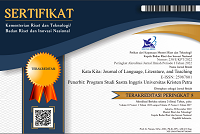Teacher’s and Students’ Perspectives Regarding the Reading Materials in the Extensive Reading and Writing Class
DOI:
https://doi.org/10.9744/katakita.9.1.53-62Keywords:
Pencahayaan Alami, Ruang Praktek, dan EnergiAbstract
This qualitative study aimed to know the teacher’s and the students’ perspectives regarding the reading materials in the Extensive Reading and Writing (ERW) class. The study used the theory of Extensive Reading Principles by Day and Bamford (2002). The study also tried to draw the similarities and differences between their perspectives. The subjects of the research were 10 students and 1 teacher from ERW class in the English Department of Petra Christian University, Surabaya. Semi structured interviews were used to explore their perspectives toward the reading materials of ER. The findings showed that the teacher and the students had various perspectives regarding the reading materials in ERW class. In conclusion, the provision of reading material was not really in line with the ER principles because of the unique nature of ERW class. For the future research, the writers suggested doing quantitative research with a variety of subjects for more generalizable result.
Keywords: extensive reading, implementation, perspectives, students, teachers
References
Anandari, C. L., & Iswandari, Y. A. (2019). Extensive reading in Indonesian schools: a successful story. TEFLIN Journal, 30(2), 137-152.
Arifuddin, A. (2018). Students’ perception in the impact of Extensive Reading course (Undergraduate Thesis, Islamic University of Indonesia). Retrieved from https://dspace.uii.ac.id/handle/123456789/7559
Barnes, B. D., & Lock, G. (2013). Student Perceptions of Effective Foreign Language Teachers: A Quantitative Investigation from a Korean University. Australian Journal of Teacher Education, 38(2).
http://dx.doi.org/10.14221/ajte.2013v38n2.2
Day, R., & Bamford, J. (2002). Top ten principles for teaching Extensive Reading. Reading in a Foreign Language, 14(2), 136–141.
Day, R. R., & Bamford, J. (2010). The benefits of extensive reading (ER). Available: http://www.oupe./es/es/ELT/Readers/bookworms/Recursos%20Destacados/the%20benefits%20of%20extensive%20reading.pdf Accessed Jul 2020.
Day, R. R., Bamford, J., Renandya, W. A., Jacobs, G. M., & Yu, V. W.-S. (1998). Extensive Reading in the Second Language Classroom. RELC Journal, 29(2), 187–191. https://doi.org/10.1177/003368829802900211
Imamura, K. (2020). Semi-structured Interviews on Extensive Reading for Japanese University Students. Extensive Reading World Congress Proceedings, 5,127-136.Semi-structured Interviews on Extensive Reading for Japanese University StudentsKazuhiro IMAMURA Mukogawa University
Downloads
Published
Issue
Section
License
Authors who publish with this journal agree to the following terms:- Authors retain copyright and grant the journal right of first publication with the work simultaneously licensed under a Creative Commons Attribution License that allows others to share the work with an acknowledgement of the work's authorship and initial publication in this journal.
- Authors are able to enter into separate, additional contractual arrangements for the non-exclusive distribution of the journal's published version of the work (e.g., post it to an institutional repository or publish it in a book), with an acknowledgement of its initial publication in this journal.
- Authors are permitted and encouraged to post their work online (e.g., in institutional repositories or on their website) prior to and during the submission process, as it can lead to productive exchanges, as well as earlier and greater citation of published work (See The Effect of Open Access).














